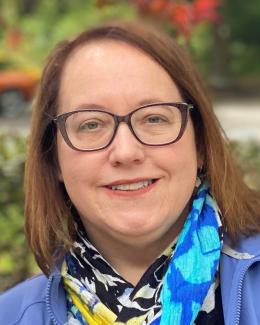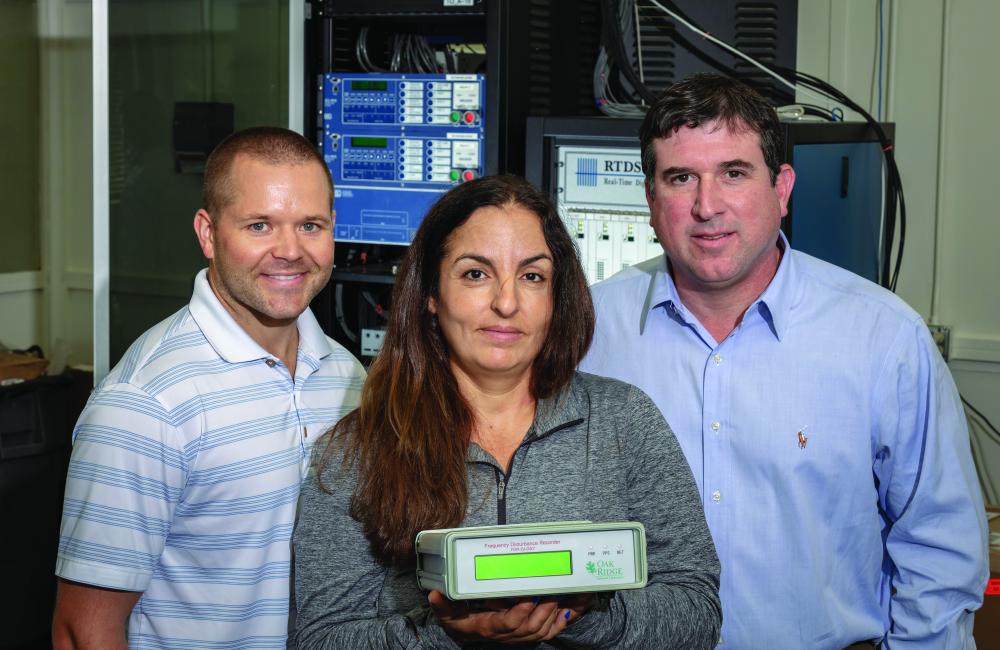From left, Nils Stenvig, Isabelle Snyder and Travis Smith of ORNL’s Power and Energy Systems Group stand in front of a digital simulator, which allows them to simulate grid equipment. Snyder is holding a GridEye sensor. Image credit: Carlos Jones, ORNL
As Hurricane Maria swirled out to sea after plowing a destructive path across Puerto Rico in September 2017, initial reports were clear: The island’s power grid lay in near ruin.
DOE and its national laboratories immediately got busy, working not only to offer solutions for rebuilding the island’s electricity network but also to make it resilient to future disruption.
At ORNL, researchers stepped in to develop models for better grid protection, analyze options for new generation sources, and deploy sensors to monitor and evaluate the grid and inform decisions by the island’s utility, the Puerto Rico Electric Power Authority.
One key development has been a planning model that places and optimizes systems called “protective relays,” which control circuit breakers and can isolate areas where power lines may be down, preventing outages from cascading system-wide. ORNL’s Dynamic Protection-Planning Model can be used to predict the behavior of the electrical system in the event of severe weather.
The tool can, for instance, take the projected path of a hurricane and analyze its impact on transmission equipment, said Nils Stenvig of ORNL’s Power and Energy Systems Group. Such information can be crucial for planning and recovery.
The model could support tasks such as predictive islanding: isolating portions of the grid expected to be hit the hardest to keep as much of the system running as possible during a storm, Stenvig noted.
Travis Smith, an ORNL protection system engineer who has worked for major utilities, had already developed advanced modeling tools for DOE that take into account protective relays. He expanded those simulations for the Puerto Rico project.
“Protection engineers know how to calibrate relays individually, but this tool gives them a way to analyze and coordinate the entire system and make improvements,” Smith said. “This is a real roadmap utilities can use to modernize their system.”
Another tool being developed for Puerto Rico analyzes locations where new power generation can be sited and integrated into the grid without costly transmission system upgrades. “Sometimes those transmission system upgrades can end up costing more than the new generation itself,” Stenvig said.
ORNL’s computational scientists are also evaluating locations on the island where equipment such as spare generators and transformers could be strategically placed for easy, secure access after a natural disaster.
To help visualize the grid in Puerto Rico and validate modeling, ORNL researchers are in the process of deploying 20 GridEye sensors that constantly monitor and report on the island’s grid.
GridEye sensors, developed by University of Tennessee/ORNL Governor’s Chair Yilu Liu, have already been deployed at hundreds of locations across the continental United States to provide wide-area situational awareness of the grid. The sensors plug into standard household outlets and record data on electrical disturbances using a patented triangulation algorithm.
The sensors are located inside utility substations, universities and commercial buildings in Puerto Rico. They are connected to the internet and synchronized with one another via a global positioning system to provide voltage, frequency and other measurements and to ensure the accuracy of researchers’ models.
In another project, ORNL is working to promote the island’s economic vitality by analyzing potential investments in microgrids. The microgrids would be made up of power generated around the island combined with energy storage. Microgrids have become increasingly popular to diversify a utility’s generation mix. ORNL researchers are working with collaborators at Sandia National Laboratories to provide technical analysis of proposed microgrid projects.
“Microgrids would make a real impact on businesses across the island,” Stenvig said. “They could potentially supply power to surrounding neighborhoods as well.”
ORNL researchers are also conceiving a more flexible system of utility poles that could, for instance, bend rather than break in high winds or could be safely collapsed ahead of a storm and then unfolded afterward. The lab’s expertise and capabilities in additive manufacturing could be leveraged to more quickly design and produce such infrastructure.
The research “fits into everything we do here at ORNL in terms of materials science, sensing, electronics, simulation, high-performance computing, and cyber-physical security,” Smith said.



